|
present Book Reviews For Amateur & Avocational Archaeologists |
 |
|
present Book Reviews For Amateur & Avocational Archaeologists |
 |
Archaeology Curation, Lab & Materials Analysis (includes Photography)
|
| Home | Gallery | Latest Finds | Back to Main Book Review Index |
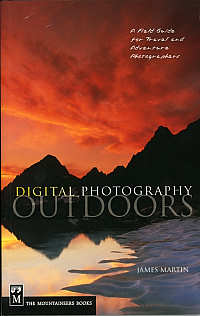
|
Digital Photography Outdoors
by James Martin The Mountaineers Books 2005 2nd printing ISBN# 0-89886-974-9 paper "My aim is to show people how to take advantage of digital's strengths without being blindsided by the perils of the new technology." So states James Martin, mountaineer, wilderness traveler and trip leader for Joseph Van Os Photo Safaris. Aside from the usual guide to the basics of exposure, lighting and computer editing of photographs, Martin points out some things other books leave out, such as how CCD size effects image composition. He also points out some good composition tips professionals regularly take for granted. I especially appreciated his explanation of lenses--- I thought I knew it all, but I was wrong. He isn't a camera snob like other authors are so often, and suggests many occasions where the "lesser" camera of lower resolution is the superior choice: Who wants to lug a full-sized, high-dollar camera, say, into a kayak down some rapids? In the end, it's knowing where you'll want to use the photos that will determine which camera is best for any situation. Martin illustrates several neat tricks, or solutions, for shots usually taken with film cameras, such as how to shoot night skies to get star-streaking. Here's an author who encourages experimentation and doesn't let you forget the importance of the darkroom, which in digital terms means creative use of computer editing software, especially Adobe Photoshop. The digital equivalent of negative "sandwiching," and how to do it in Photoshop is discussed and illustrated fully, as are many other techniques and terminology. Perhaps the most useful tips for most of us will be his sections on file organization and archival practices. Most people mistakenly save every shot they take, never following any naming or filing conventions, and therefore, can seldom find a shot when they need it. Also, improperly archiving your pictures will result in disappointment later when you find you have zero flexibility in how you can use the photo for printing, etc. Martin has created a simple flow/work chart that will help every photographer who reads the book. As a field surveyer, mapping archaeological sites, I'm always outdoors
and always carry a camera. I plan on carrying this book around with me
as a quick reference for awhile, till I've got all of his tips mastered---
the author's photographs, liberally used throughout the book, are just
awesome! Maybe, just maybe, it will help me capture a masterpiece!
Another handy book from The Mountaineers Books. Order Digital
Photography Outdoors for $16.95, direct
from the publisher, by clicking here.
reviewed by Bob
Wishoff
|

|
Understanding Stone Tools and
Archaeological Sites
by Brian P. Kooyman University of New Mexico Press 2001 2nd pr ISBN# 0-8263-2333-2 paperback Used in its early draft as a textbook for the author’s class in Prehistoric Stone Tools and thus “field-tested”, Understanding Stone Tools and Archaeological Sites is an excellent introduction to broader aspects of the significance of lithics in defining not only the tool making activities present at a site but also in interpretation of other social processes such as sourcing, defining contact, exchange and material transportation and more. After introducing us to the raw materials, we are shown techniques of flintknapping (Brittle Material Fracture Mechanics) and the nomenclature of flakes and cores. The author presents reasons for knowing where raw materials come from and explains various methods of chemical and non-chemical material sourcing. The section about the physics of flintknapping is amazing and will challenge your ability to visualize the movement of the waves of force which produce rippling and scarring of flakes and cores. Kooyman will have you looking at every flake you see through fresh eyes. You'll quickly appreciate the many illustrations and photographs used in the book. Carrying forward with this idea, Kooyman next examines the prevailing thoughts regarding lithic reduction strategies and techniques. Flake types can tell a researcher much about what stage in the manufacturing process was going on, and further, when an entire excavation’s inventory of flakes is mapped by type distribution over the excavation map, patterns of social behavior can begin to be seen. The researcher’s objective is to view the lithics at a site in-toto—for example: “If most… material is present as finished tools and resharpening flakes, trade is more likely to be the source of the material…Material is probably of local origin if much early stage debitage is present and/or if large cores and blocks of raw material are present.” Once the reader understands these things a broad overview of Worldwide Lithics Technology is next. Not a complete history of lithics, but an attempt “to put some of the main innovations into chronological perspective.” After all of that, the reader is ready for the real “meat and potatoes” topics of the book The study of lithic production variables shows how various experiments in labs (controlled breaking) and by modern flintknappers as well as examinations of fracture mechanics theories are all designed to “determine what aspects of technology, such as hammer type, produce particular features and forms in tools and debitage.” How an item should look, what its purpose is, and what materials it should be made of are only some of the issues involved in finding the meaning of form in lithic tools. This topic must be understood in order to make sense of what is found at an excavation. Topics such as Use Wear Analysis are introduced and explained. The Cultural History of the Northern Plains Stone Tools are next examined with each phase/complex having its characteristic lithic tools listed along with a short treatment on the lithic technology utilized. It’s a logical step to then explore the wide applications of lithic analysis: Site type and settlement patterns; Intra-site patterning; and other related topics are discussed. Use wear and residue analysis is also discussed. There is a lot of material stuffed into this 200 page book! You’ll appreciate the great glossary, and the extensive bibliography, too! If you want to know more about lithics and their broader meanings within archaeological and anthropological contexts, then this book is for you! Kooyman takes a complex topic and makes it an easy and interesting read! The University of New Mexico Press is presently updating their website
so a direct link to this book is best visited through the front door by
clicking here. Understanding
Stone Tools and Archaeological Sites sells
for $29.95.
reviewed by Bob
Wishoff
|
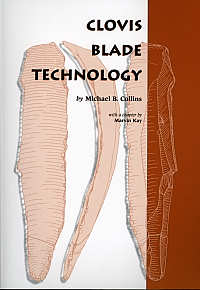
|
Clovis Blade Technology
by Michael B. Collins with a chapter by Marvin Kay University of Texas Press 1999/ 2002 1st paperback edition ISBN# 0-292-71235-9 Clovis is a technology, not a culture! Dr. Michael Collins will tell you that right off: We all make a mistake looking for some kind of homogenous ancient culture when we look at Clovis technology. Technology is dispersed, historically, among many peoples, and Clovis technology is no different. We are nearly totally ignorant of so-called Clovis lifeways and this book makes no attempt to add to this side of the inquiry, rather, it is an elegant discussion of the technology of Clovis blade manufacture, providing the reader with copious quantities of hard data presented within analytical and comparative contexts. Collins laments that most Clovis artifacts are found out of context, or were not well documented. Recently, he had the good fortune to excavate the now-famous Gault site, a definite exception to the rule: Years of research remain on what has proven to be one of the most well-preserved paleolithic sites in North America. Clovis Blade Technology is broken into three parts, the first of which introduces us to Blade Technology and Its Place in North American Prehistory and A Review of Clovis Lithic Technology in which the basic forms of blades (defining what a "true blade" is, for example) are shown as well as how they were made. Discussed also are the resultant "prismatic" cores. We learn that though many studies have been made, and much has been written about Mesoamerican blades, little has been explored relevant to North American examples. "What is Clovis?" is just one of the issues discussed in A Review of Clovis Lithic Technology. This section will answer, or put into focus, many of the questions about Clovis routinely passed between professionals, avocationalists and amateurs alike. Reading this part of the book, avocationalists and amateurs should be immediately alerted to just what is considered an important artifact for study (especially when found in context) as many of the Clovis blades could be passed over by the uninformed as uninteresting debitage. What you should be seeking for evidence of paleolithic occupation are flake blades and prismatic cores! This was the hot technology of the ancient world! The second part of the book is where we see hard data: Archaeology in action. Collins meticulously and methodically takes us through an examination of all of the finds from The Kevin Davis Site, a Clovis Blade Cache. Artifacts are measured and compared from every possible angle. Microscopic edge analysis is explained and charts are shown for all of the blades. All of this examination results in a pretty 'dense" read. You'll likely find yourself springboarding off to research some of the highly technical concepts introduced here and Collins supplies plenty of references to aid in this quest. The final section of the book compares blade data from many Clovis sites as well as including a discussion of caching behavior. Caching makes sense only when someone plans to return to a location, making the discovery of a cache an important find. The blade comparisons separate different degrees of context, keeping say, definitely Clovis site finds, seperate in comparison from those found in probable or indefinite contexts. Affecting the comparisons, however, were the different data sets and record-keeping from multiple excavators and researches. Not all of the researchers, for example, took note of each blade's curvature, making comparisons in this range possible only some of the time. The author makes note of the similarity of Clovis blades to those in southwestern Europe: Could this technology have come from other than Asia, as presently thought? Why is Clovis technology more common in North America than in South America? The Postscript illuminates us on the latest research news. If you are interested in paleolithic archaeology and lithic technology,
this book is a must-read. Hard to find for awhile, it has finally been
re-issued as a paperback. Clovis Blade Technology
can be ordered directly from the publisher, for a web-special price of
only $20.07 (regularly $29.95), by clicking here.
reviewed by Bob
Wishoff
|
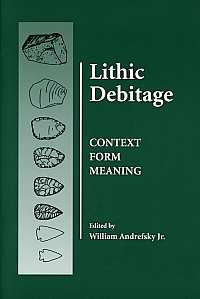
|
Lithic Debitage:
Content Form Meaning edited by William Andrefsky, Jr. University of Utah Press 2001 2nd edition ISBN# 0-87480-768-9 paperback An important function of archaeological research is determining what materials found at a site are diagnostic, the presence of which can illuminate the use of a site, or the site's age. Anyone who has walked a site, or excavated one, has examined loads of flint flakes, or lithic debitage, the leftover bits from the lithic reduction process. Until relatively recently, the more ephemeral bits observed at an excavation were not counted: Rabdotus snail, and lithic reduction materials were simply noted as present. Nowadays, these items are recognized as relevant, and every researcher has toiled over them, washing and counting every piece. Paleolithic site excavators frequently note the in-situ placement of every single flint chip as it's now known of their many uses: They're not simply debitage, or leftover trash, but sometimes tools. The editor of this book sees the examination of lithic debitage as a field of research in its dawn, and has compiled the most recent collection of publications and essays by the world's leading experts, on the topic to date. Can lithic debitage be used to determine what kinds of tool production took place at a site? Can lithic debitage examination even assist in providing clues as to a site's overall functions, people's mobility and other anthropological information? In the chapter "Emerging Directions in Debitage Analysis", the reader is made aware of all existing processes dealing with debitage. There's a whole range of methods of measuring and counting the flakes from an excavation, and current thinking is that by finding the right means of examining and sorting the flakes, we might be able to determine exactly what was being manufactured at sites. Researchers have taken to reproducing the artifacts found at sites, then studying the resultant lithic debitage, and comparing them to what has been found on actual excavations. Extensive discussion is represented of debitage found within archaeological contexts in Arizona, Alaska and Peru. Given that in some sites, the mass of excavated flakes reaches into the 10's of thousands, there has got to be a great reason for each flake to be assessed individually. Most researchers tend to sort the flakes by size, and whether they are perceived to be pressure or percussion made. The editor outlines at least 6 other methods, some measuring the lenght/width and weight of each and every flake, as well as determining the percentage of cortex of the flakes, all being compared to lab-made specimens. It is apparent that futher research is trending toward the development of a taxonomy for flakes, a guide to flake types analysed and grouped by weight, thickness and other criteria, to help assist field archaeologists better assess excavated materials. By mapping out the "spread" and deposit of lithic debitage across sites, then comparing this to other sites, researchers are evolving the concept of a "distinctive assemblage" typology whereby production strategies can be assessed by studying these lithic debris patterns. At this time research is focused on determining the viability and reliability of such comparisons. Though not a book one would read while lounging in a hammock on a sunny day, this complex collection of publications is important, being the first volume to address interpretation of debitage as relevant to the majority of archaeologists in the field and lab. It is an example of the level of detail now being pursued by the evolving science of archaeology in an attempt to get the fullest picture possible of ancient lifeways. Anyone who surveys sites, or is involved in serious excavation assesment work, will want to read this book to see what's on the horizon in this emerging field of research. Lithic Debitage may
be ordered directly from the publisher for $20 by clicking here.
reviewed by Bob
Wishoff
|
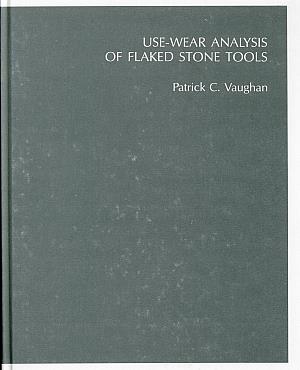
|
Use-Wear Analysis of Flaked
Stone Tools
by Patrick C. Vaughan University of Arizona Press 1985 1st ed ISBN# 0-8165-0861-5 cloth hardback . “What did they use that for?” is a question most everyone wonders when they look at nearly any stone tool. Use-wear analysis is a step toward finding this out and a term that pops up everywhere in archaeological research these days. Use-Wear Analysis of Flaked Stone Tools is a book that will answer a lot of your questions about this important investigative procedure. “Since the basic goal of most early lithic studies was the ordering of prehistoric tools along chronological and geographical lines, the precise function of individual stone implements was not the principal concern of the time. Yet aspects of the speculative functional approach have continued up to the present day, even after the development of stone tool classifications which rely principally on morphological and technological criteria.” So along comes Serge Semenov and his seminal tome Prehistoric Technology in 1964 in which he “demonstrates the necessity of systematic tool use experimentation and microscopic examination of wear traces.” Not that other researchers didn’t notice the striations occurring on worn edges of tools, it was the systematic approach that was missing and even Semenov made assumptions which limited perspective on the topic. What we have here is a very complex book about what would ordinarily seem like a straightforward process and idea. Examine and photograph under high and low power microscopy modern-made stone tools after using them on various forms of materials. But it is the evolution of consistent methodology that is key to this kind of study and a central part of the book. Trying to work realities such as keeping the multiple use of a single tool within the range of possible assessment is just one of the difficult problems the methods must deal with. The incredible range of actual possible materials also adds complexity. After explaining that “It is now sine qua non that a functional analysis of prehistoric stone tools must be based on the experimental results of a wide framework of use-wear tests”, the author explains the scope of the experimentation, classes of microwear (which go well beyond the striations alone which characterize Semenov’s work), and methods and variables (such as materials, residues and knapping procedures). Now Vaughan presents the result of experimental use-wear on three types of flint. The major categories of wear traces presented are: microchipping,striations, rounding, micropolishes and residues, each category having sub-categories, such as microchipping from intentional use and striation from nonuse factors, etc. Reading the descriptions of these categories for the first time can be most difficult! But be patient, and realize that having actual samples to view at this point would make things much clearer: be sure to look at the referenced plates. The author’s intent is to show application of the experimental use-wear data and does so by presenting a study of an 18,000 year old Magdalenian flint assemblage from the cave at Cassegros in southwestern France. “In addition to defining the functional composition of the cave’s excavated stone tool assemblage, the study investigates the relations between the discernible function and the typology, technology and distribution of the prehistoric flints.” Vaughan presents the study hoping it will act “as an incentive toward more representative functional analyses” rather than “studies of isolated tool groups.” The last part of the book is a plate section containing 170 keyed plates of flint micrographs of use-wear traces of numerous types. An important reference which the author cautions would find a researcher in error if used alone as a guide. The extensive bibliography is also welcome as further inquiry into this topic is almost inevitable! Order Use Wear Analysis of Flaked Stone Tools
direct
from the University of Arizona Press for $57.00 by clicking here.
reviewed by Bob
Wishoff
|
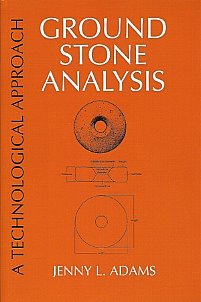
|
Ground Stone Analysis: A Technological
Approach
By Jenny L. Adams University of Utah Press 2002 ISBN # 0-87480-717-4 paperback Although flaked projectile points get the lion’s share of attention in studies of prehistoric lithic artifacts, the study of ground stone tools and their use in the life of those who produced and utilized them is growing. It is a subject that Jenny Adams, a specialist in ground stone analysis with the cultural resources research and consulting firm Desert Archaeology, has investigated extensively over the past decade. Her expertise in this much neglected field of research is now available in a definitive book that offers many insights for both the avocational and professional archaeologist. Adams lays out “the groundwork” (her pun, not mine) for the scope of - her research in the first chapter. Her categories are broad, including processing tools, manufacturing tools, pigments and pecking stones, hammerstones, and abraded, polished or impacted tools, with analysis coming from fields of ethnography, experiments (including use-wear analysis), and archaeological findings (including those from the field of ethnoarchaeology). She does delve briefly into various classification techniques, including classic and set theory, she does seem to favor fuzzy set theory, bearing in mind that “…the shape of an artifact today does not always reflect it’s originally designed shape”, and that “…function is better defined…by design than by form…Sometimes those items closest to the fuzzy boundaries are the most interesting and may represent technological innovations, experimentations, or adaptations from foreign traditions.” The next two chapters then delve first into some of the more esoteric aspects of tribology (the science of friction, lubrication, and surface interactions) of grinding surface design, manufacture, use, wear and analysis, and then into ethnographic and experimental behavioral models for better understanding actual usage of ground tool materials in the real world. This experimentation with hand made implements is clearly a subject especially dear to the author’s heart, as evidenced by a table on the differing results from three different metates on five different native grains, including the time required, the quality of the resulting meal and even amount of rock fragments or rock dust produced in each case! The last, and largest, portion of the book includes descriptions of the wide variety of ground stone artifacts, from the well known (such as manos and metates) to the truly unusual and unexpected, such as “bell stones”. (“Bell stones are recognizable in the archaeological record only because they were used in historic pueblos, such as Taos, where they were seen and described by archaeologists…Suspended by a leather thong, the long stones were struck in a way that caused them to reverberate loudly enough to summon the men to a meeting…”) Although Adams draws her material primarily from the American Southwest, a partial listing from the table of contents will be enough to demonstrate that these artifacts also have a much wider geographical bearing. “Abrading, Smoothing and Polishing Tools; Grinding and Pulverizing Tools: Percussion Tools; Hafted Percussion Tools; Spinning Tools; Perforating, Cutting, and Scraping Tools; Paraphernailia (Atlatl Parts, Balls, Bell stones, Cruciforms, Cylinders and Medicine Stones, Disks, Lighning Stones, Plummets and Weights, Pipes and Tubes, Shaped Stones, Pigments, Natural Stones, Personal Ornaments, Figurines); Containers and Container Closures; Structural Stones (…Cooking Stones…Fire-Cracked Rock)” The illustrations include photographs and well executed line drawings of artifact types, as well as demonstrating their utilization and wear patterns. Diagrams at the beginning of some of the artifact chapters also make it clear how the characteristics of the items often overlap, clarifying the author’s preference for “fuzzy” typology. The appendices, which consist of forms for listing six different types of artifacts (general, handstones, netherstones---including lapstones, metates, anvils, bowls and mortars, hafted tools, grooved tools and perforated tools) should not be overlooked either. The attribute explanations and descriptors found there are valuable in broadening the reader’s vocabulary and scope of definition for ground stone artifacts. The glossary is also helpful in understanding the terminology used throughout the book. Adams succinctly sums up the importance of this subject at the end of her opening chapter. “The items grouped under the heading ground stone were intimately interwoven into the daily activities of prehistoric people. We thus have the opportunity to learn about more than just the things people used. We can learn about how people planned to use their tools, and then compare that to how the tools actually were used. We can learn about how tools were discarded or destroyed. If the data are appropriately organized, we can select specific attributes that will let us evaluate the motions employed with specific tools. This may be one of the best ways to learn about the intimate details of prehistoric life.” This is a book that anyone with an interest in prehistoric American artifacts will find not only unique but useful in understanding the remnant technology of prehistoric life. 336 pages long, with 80 illustrations, it can be purchased directly from the University of Utah Press at their website (click here) for $25.00. It’s a reference work you’ll wonder how you ever did without. For the reader with a further interest in Adams’ work, her article
on the ground stone artifacts found during the 2000-2003 Rio Nuevo Archaeology
project in Tucson, Arizona can be found at the Center
for Desert Archaeology (scroll the page down to the link for Chapter
9: Ground Stone Artifacts).
reviewed by Charles
Swenson
|
| Home | Gallery | Latest Finds | Back to Main Book Review Index |